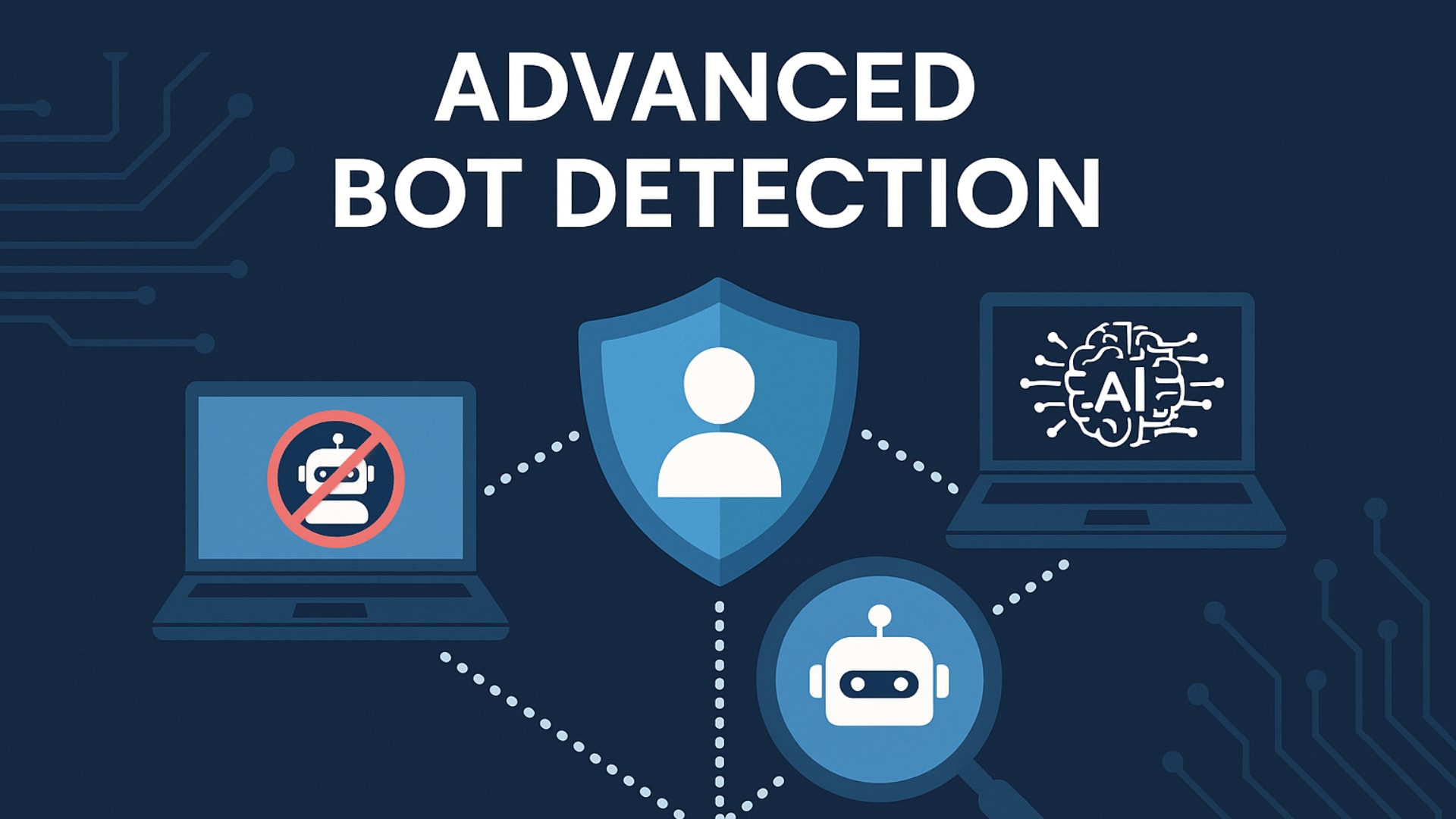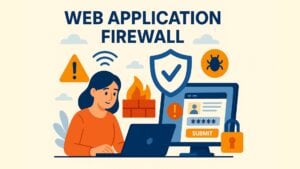
Table of contents
What is Advanced Bot Detection?
Advanced bot detection goes far beyond basic methods like CAPTCHAs. While CAPTCHAs can block basic bots, sophisticated bots can often bypass them. Advanced bot detection uses multiple defense mechanisms to identify and neutralize malicious bots in real-time. The goal is to protect websites, APIs, and applications from harmful bots, including those involved in web scraping, account takeovers, DDoS attacks, and online fraud. As AI systems and large language models (LLMs) become more prevalent, protecting content from unauthorized scraping has become increasingly important. Advanced bot detection provides precise control over identifying specific threats and applying tailored responses, including unique rules to stop AI-driven scraping attempts.
At captcha.eu, our CAPTCHA solution is part of this advanced bot detection framework. We offer a GDPR-compliant, user-friendly CAPTCHA that helps detect and prevent bot-related activities, ensuring secure interactions for all users.
Role of AI in Bot Detection
AI plays a crucial role in modern bot detection systems. With machine learning, these systems can analyze behavioral patterns, adapt to new bot tactics, and recognize subtle anomalies in web traffic. AI-powered detection can discern bots from legitimate users by analyzing large datasets in real time. For instance, systems like FortiGuard Advanced Bot Protection use continuous learning to understand and protect against bot threats, including account takeovers, data theft, and service disruptions. These systems constantly learn new attack patterns and bot behaviors, making them more effective over time. As bots get smarter, AI detection systems also improve, allowing them to stay ahead of new threats.
At captcha.eu, we integrate AI-powered CAPTCHA challenges into our solution. Our system uses machine learning algorithms to analyze patterns and adapt to evolving bot behaviors, providing a dynamic layer of protection for your website.
Types of Bot Detection
Advanced bot detection employs various methods to spot malicious bots. These techniques analyze patterns and behaviors that differentiate bots from human users. Here are some key methods:
Behavioral Analysis
Behavioral analysis tracks user interactions and recognizes patterns indicative of bots. This includes examining mouse movements, click patterns, typing rhythms, and time spent on a page. By using machine learning, these systems detect even the most subtle deviations from normal human behavior, allowing for more accurate bot detection.
At captcha.eu, we analyze user interactions to ensure that only genuine human users can pass our CAPTCHA challenges. This ensures real-time protection and prevents bot activity without hindering legitimate user experience.
Browser and Device Fingerprinting
Browser and device fingerprinting creates a unique identifier for each user based on their device and browser configuration. This includes attributes like browser type, version, operating system, screen resolution, and installed plugins. By combining these elements, detection systems can improve accuracy in identifying bots.
IP Address Analysis
IP address analysis evaluates the reputation of an IP address, the number of requests made from the same address, and its geographical location. This method helps identify suspicious traffic from data centers or known bot networks, adding another layer to bot detection.
CAPTCHA Challenges
CAPTCHAs present challenges that humans can easily solve but bots cannot. These challenges are often triggered when bot-like activities are detected. However, modern bots are getting better at bypassing CAPTCHAs or mimicking human actions, so these challenges alone are no longer sufficient to stop bots.
At captcha.eu, we ensure that our CAPTCHA solution is continuously evolving to prevent even the most sophisticated bots from bypassing our security checks.
Traffic Analysis
Traffic analysis looks for unusual traffic patterns, such as sudden spikes, high bounce rates, or suspicious sources. By examining these anomalies, it can help detect bot activity in real time, allowing for immediate action to mitigate potential damage.
Biometric Detection
Biometric detection monitors client-side events like mouse movements and keystrokes. It can identify bot behavior by matching these actions against a set of known human patterns. It also helps detect CAPTCHA circumvention attempts.
Continuous Adaptive Learning
Systems with continuous adaptive learning use deep learning algorithms to monitor and correlate data over time. These systems can evolve and adapt, recognizing new bot behaviors and circumvention tactics, making them an important part of modern bot detection systems.
Challenges in Advanced Bot Detection
Evolving Bot Behavior
One of the biggest challenges in bot detection is the ever-evolving behavior of bots. Bots now imitate human actions so convincingly that even advanced systems struggle to tell them apart from real users. Bots simulate mouse movements, typing patterns, and time spent on pages—making them harder to detect. This constant evolution means detection systems must continuously adapt to keep up.
AI and Machine Learning Complexities
While AI and machine learning enhance bot detection, they introduce their own set of challenges. These technologies rely on vast amounts of data and complex models, and even then, they may produce false positives. Identifying legitimate human users as bots is a significant issue, and finding the right balance between accuracy and user experience remains difficult.
CAPTCHA Limitations
CAPTCHAs, a common method for bot detection, face increasing limitations. Sophisticated bots are now capable of solving CAPTCHA challenges or mimicking human behavior to bypass them. However, captcha.eu provides an advanced, AI-powered CAPTCHA solution that adapts to new bot behaviors and prevents even the most sophisticated bots from bypassing security measures. Our solution ensures that websites are protected without compromising the user experience, continuously evolving to stay ahead of new bot tactics.
Scalability Issues
As websites grow and traffic increases, detection systems often struggle to process high volumes of requests in real time. With more sophisticated bots and larger traffic spikes, it becomes challenging to quickly and accurately distinguish between bots and legitimate users. This can lead to delays and inefficiencies in bot detection, especially during peak traffic times.
Bot Mitigation Strategies
Once bots are detected, the next step is mitigation — blocking bots from causing harm to the website or application while ensuring legitimate users can still access the site.
One of the most effective strategies is rate limiting, which restricts the number of requests from a single IP within a specific timeframe. This prevents bots from overwhelming the site with excessive traffic and ensures genuine users are not affected. At captcha.eu, we integrate rate limiting with our CAPTCHA solution, stopping bots from flooding your website while allowing legitimate users to interact freely.
Another powerful method is challenge-response tests, like advanced CAPTCHA challenges. These tests present tasks that are simple for humans but difficult for bots, requiring additional interaction. When suspicious behavior is detected, these challenges are triggered dynamically, adding an extra layer of defense.
Device and browser fingerprinting is also crucial in bot mitigation. By creating a unique identifier for each visitor based on their browser and device configuration, websites can track and block suspicious activity over multiple sessions. Whcih is improving the effectiveness of bot prevention.
For more advanced mitigation, IP blocking and proxy detection can prevent bots from accessing your site by blocking known malicious IPs or proxies that bots use to disguise their origin. This method cuts off harmful bots in real-time.
At captcha.eu, we combine these strategies to ensure that even sophisticated bots are blocked. Our dynamic CAPTCHA challenges adapt to user behavior and evolving bot tactics, providing ongoing protection.
Modern mitigation systems also rely on adaptive security models, using AI and machine learning to monitor, adjust, and respond to new threats in real-time. This level of adaptability is essential to stay ahead of bot threats.
Trends in Advanced Bot Detection
The need for advanced bot detection has never been greater, as bots are evolving rapidly. AI-powered bots, in particular, have become more adept at imitating human behavior and bypassing traditional anti-bot measures. Developers are working on increasingly sophisticated detection systems that can evolve alongside these bots.
One of the biggest drivers in bot detection development is the rise of autonomous bots, which can act with greater independence and intelligence. These bots are more difficult to track, and as they improve, bot detection systems must also advance. To keep up, many detection solutions are incorporating adaptive learning and AI models that can respond to emerging threats in real time.
Another significant trend is the rise of AI-based scraping technologies that use large language models to scrape content from websites. These technologies are more efficient at bypassing traditional bot detection systems. Which is prompting the need for new techniques that are more resistant to AI-driven scraping.
Conclusion
Advanced bot detection is crucial for keeping websites, APIs, and applications secure. As bots continue to evolve, using intelligent, multi-layered detection systems powered by AI and machine learning ensures that you can stay ahead of emerging threats.
To protect your website effectively, consider using user-friendly and privacy-compliant solutions like captcha.eu. Our CAPTCHA solution helps distinguish between human users and automated bots, providing a seamless, GDPR-compliant way to safeguard your digital operations. With captcha.eu, you can block bots and prevent abuse, ensuring the security and functionality of your website.
100 free requests
You have the opportunity to test and try our product with 100 free requests.
If you have any questions
Contact us
Our support team is available to assist you.




